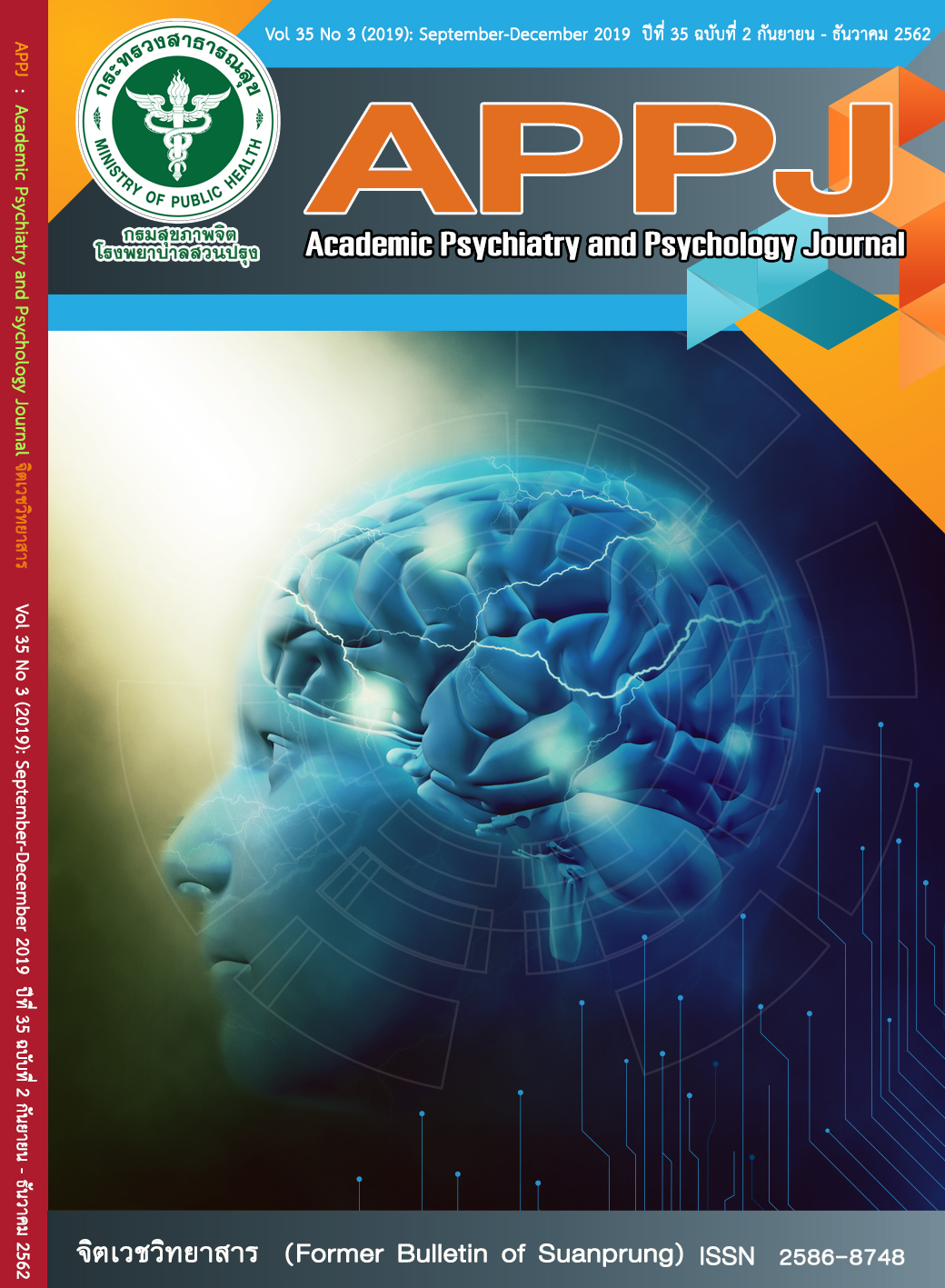Experience in Group Art Counseling of Undergraduate Students with a Tendency to Emotional Crisis
Main Article Content
Abstract
Objectives: To investigate the experience of undergraduate students with a tendency to emotional crisis in attending group art counseling.
Methods: The informants were 8 undergraduate students who had participated in a 6-session, weekly program, and whose posttest scores of the Emotional Crisis Inventory for Thai University Students had increased. The data collected from interviews conducted from 22nd May – 31st August, 2014 was analyzed using phenomenological method.
Results: The analysis of the interviews from the 8 informants revealed three main themes as follows:
1) Hesitation to disclose oneself: the informants were reluctant to express themselves at the beginning of the group counseling;
2) Life difficulties: they had experienced negative situations that affected their lives;
3) Insights through group art counseling experience: the informants gained insights about themselves and others through the process.
Conclusion: Art making in a group can be beneficial to several aspects of group process. The informants gained insights through group process and art making in group.
Article Details
บทความหลังผ่านการปรับแก้จากกองบรรณาธิการแล้ว เป็นลิขสิทธ์ของวารสารจิตเวชวิทยาสาร โรงพยาบาลสวนปรุง กรมสุขภาพจิต กระทรวงสาธารณสุข ห้ามเผยแพร่เพื่อประโยชน์ทางการค้าโดยไม่ได้รับอนุญาต แต่อนุญาตให้เผยแพร่บทความดังกล่าวเพื่อประโยชน์ทางการศึกษาแก่ประชาชนทั่วไป ทั้งนี้กองบรรณาธิการไม่จำเป็นต้องเห็นด้วยกับบทความหรือข้อคิดเห็นใดๆ ที่ปรากฏในวารสารสวนปรุง
References
2. Warinthorn R. Sources of stress in Chulalongkorn University undergraduate students (Dissertation). Bangkok: Chulalongkorn University; 2004. [in Thai]
3. Sukunya R. Depression and suicidal behaviors among Naresuan University students. J Psychiatr Assoc Thailand. 2013 Dec [cited 2015 Jun 15]; 58(4). Available from: http://www.psychiatry.or.th/JOURNAL/58-4/06-Sukanya.pdf. [in Thai]
4. Kotrajaras S, Taephant N, Tuicomepee A. Dealing with emotional crisis: a phenomenological exploration of Thai helpers’ perception and experiences. In: Ali S, Henton J, Aspin DN, Hudson M, Baber W, Kiser K, et al. editors. ACP 2013. Proceedings of the 3rd Asian Conference on Psychology and the Behavioral Science; 2013 Mar 28-31; Nagoya, Japan. Nagoya: The International Academic Forum; 2013. p. 312-18.
5. Jasonik EH. Crisis counseling: A contemporary approach. Boston: Jones and Bartlett; 1994.
6. Pitchaya J. Post-emotional crisis experience of university students: A consensual qualitative study (Dissertation). Bangkok: Chulalongkorn University; 2011. [in Thai]
7. James RK. Crisis Intervention Strategies. 6th ed. Belmont: Thomson/Brooks/Cole; 2008
8. Roberts AR. Bridging the past and present to the future of crisis intervention and crisis management. In: Roberts AR, editor. Crisis intervention handbook: Assessment, treatment, and research. 3rd ed. New York: Oxford University Press; 2005. p.3-34.
9. Corey G. Theory and practice of group counseling. 8th ed. Belmont: Brooks/Cole; 2012.
10. Trotzer JP. The counselor and the group: Integrating theory, training, and practice. 4th ed. New York: Routledge; 2006.
11. Gladding ST. Counseling as an art: The creative arts in counseling. Alexandria: American Association for Counseling and Development; 1992. p. 6-8.
12. Bell CE, Robbins SJ. Effect of Art Production on Negative Mood: A Randomized, Controlled Trial. Art Ther. 2007 Jan [cited 2015 Aug 8]; 24(2). Available from: https://www.tandfonline.com/doi/abs/10.1080/07421656.2007.10129589.
13. De Petrillo L, Winner E. Does art improve mood? A test of a key assumption underlying art therapy. Art Ther. 2005 Jan [cited 2015 Aug 8]; 22(4). Available from: https://www.tandfonline.com/doi/abs/10.1080/07421656.2005.10129521.
14. Bolwerk A, Mack-Andrick J, Lang FR, Dörfler A, Maihöfner C. How art changes your brain: differential effects of visual art production and cognitive art evaluation on functional brain connectivity. PLoS One. 2014 Jun [cited 2017 Dec 25]; 9(7). Available from: https://www.ncbi.nlm.nih.gov/pmc/articles/PMC4077746/.
15. Langdridge D. Phenomenological psychology: Theory, research and method. Harlow: Pearson Education; 2007.
16. Kotrajaras S, Taephant N, Tuicomepee A. The emotional crisis inventory for Thai university students manual. Bangkok: Center for Psychological Assessment; 2012.
17. Giorgi AP, Giorgi BM. The descriptive phenomenological method. In: Camic PM, Rhodes JE, Yardley L, editors. Qualitative research in psychology: expanding perspectives in methodology and design. Washington: American Psychological Association; 2003. p. 243-73.
18. Lincoln YS, Guba EG. Naturalistic inquiry. California: Sage Publications; 1985.
19. Yalom ID. The theory and practice of group psychotherapy. New York: Basic Books; 2005.
20. Rankanen M. Clients’ positive and negative experiences of experiential art therapy group process. Arts Psychother. 2014 Apr [cited 2015 Jan 27]; 41(2). Available from: https://www.sciencedirect.com/science/article/abs/pii/S0197455614000264.
21. Riley S. Using art therapy to address adolescent depression. In: Malchiodi C, editor. Handbook of art therapy. New York: The Guilford Press; 2003. p. 220–27.
22. Rubin JA. Artful therapy. Hoboken: John Wiley & Sons; 2005.
23. Linesch D, Ojeda A, Fuster ME, Moreno S, Solis G. Art therapy and experiences of acculturation and immigration. Art Ther. 2014 Jul [cited 2019 Apr 5]; 31(3). Available from: https://www.researchgate.net/publication/315663141_Art_Therapy_and_Experiences_of_Acculturation_and_Immigration
24. Kawachi I, Berkman LF. Social ties and mental health. J Urban Health. 2001 Sep [cited 2019 Apr 6]; 78(3). Available from: https://www.ncbi.nlm.nih.gov/pmc/articles/PMC3455910/

